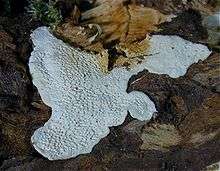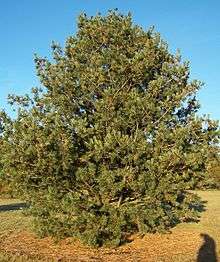Heterobasidion annosum
| Heterobasidion annosum | |
|---|---|
 | |
| Scientific classification | |
| Kingdom: | Fungi |
| Division: | Basidiomycota |
| Class: | Agaricomycetes |
| Order: | Russulales |
| Family: | Bondarzewiaceae |
| Genus: | Heterobasidion |
| Species: | H. annosum |
| Binomial name | |
| Heterobasidion annosum (Fr.) Bref. (1888) | |
| Synonyms | |
|
Boletus annosus | |
| Heterobasidion annosum | |
|---|---|
|
| |
| pores on hymenium | |
|
no distinct cap or offset | |
| hymenium is decurrent | |
|
lacks a stipe or is bare | |
| spore print is white | |
| ecology is parasitic | |
| edibility: inedible | |

Heterobasidion annosum is a basidiomycete fungus in the family Bondarzewiaceae. It is considered to be the most economically important forest pathogen in the Northern Hemisphere. Heterobasidion annosum is widespread in forests in the United States and is responsible for the loss of one billion U.S. dollars annually. This fungus has been known by many different names. Commonly, it is also known as annosum root rot. First described by Fries in 1821, it was known by the name Polyporus annosum. Later, it was found to be linked to conifer disease by Robert Hartig in 1874, and was renamed Fomes annosus by H. Karsten. Its current name of Heterobasidion annosum was given by Brefeld in 1888. Heterobasidion annosum is one of the most destructive diseases of conifers.[1]
Description

The fruiting bodies of the fungi, which are also known as basidiocarps, are whitish around the margins, with button shaped pads, and dark brown on the upper surface. This fruiting body is created from mycelium, the mass that forms around the vegetative portion of the a tree body, i.e. that part of the tree with no differentiation like stem, leaves, or in this case roots. Basidiocarps are about 40 cm in diameter and 3.5 cm thick.[1] The lower surface of the fruiting body is made of visible pores that are between 5 mm and 26 mm. Sexual spores are created from the basidiocarps, called basidiospores. Conidiospores occur in the asexual stage and are produced on conidiophores. Conidiospores and basidiospores are both produced by fungus, the latter being more important for infecting the conifers.
Ecology and life cycle

In the summertime, basidiospores, the primary infective propagules, are released. These basidiospores are carried long distances by wind currents. They infect trees through damage such as freshly cut stumps. Once on the stump the fungus colonizes and moves into the root via mycelium. The Heterobasion annosum moves short distances from the roots of an infected stump through root grafts with other trees. It can also spread through insects that feed on roots.[1][2] Since this fungus can not move very far through soil, it relies on tree roots to help it infect neighbouring trees. In these roots, it can grow 0.1–2.0 m per year. This results in a spread of the fungus and disease gaps in the forest. These disease gaps are produced when the trees dies and falls, creating gaps in the forest canopy. These gaps affect the moisture and sunlight available, altering the habitats for plants and animals on the forest floor. Spiniger meineckellus, the name for of the asexual stage of this fungus, is produced on stumps when the conditions are moist, and the conidiospores that are produced will be able to live in the soil for up to ten months. The role of conidiospores is unknown in the infection process and is not thought to be important.[1]
Symptoms and signs of disease
Symptoms and signs of fungus disease are often found underground. The H. annosum infections cause an abnormal change in structure in the roots that climbs up to the butt of the tree. More than half the tree may be killed before any symptoms appear to the human eye. Basidiocarps can take up to one and a half or even three years to be visible. This infections causes the trees to have abnormal needle growth, pale yellow barks, and the trees to wither and die. This root disease typically causes the tree to have a thin crown from bottom up and inside out. Trees will eventually die. A landscape scale symptom is the rings of dead trees in various stages of decay and death, with the oldest at the center and progressively younger moving outward. The white rot fungus found in the roots is the sign of telling whether the tree has been affected by H. annosum. The bark changes colors as the stages progress, they go from pale yellow, to a crusty light brown, and finally in its advanced stage it turns white with the signature of Fomes annosus ― a sprinkled streak of black spots. Another sign is the leaking part of the root that causes a compact mass to form between it and the sand.[1]
Isolation
There are several ways to isolate Heterobasidion annosum. Water agar could be used with infected host tissue to produce conidiophores which a simple or branched part hypha of a fungus to eliminate heterobasidion annosum. Another way of isolating heterobasidion annosum is by using the thin disks of living sapwood from Picea abies. By cutting the thin disks into petri dishes which is used to culture bacteria and placing them on moist filter paper, this technique allows spores to be captured from the air, and result in the asexual stage of the fungus forming on the disks.[1]
Management
Theoretically, a root can be suppressed during all stages of its life cycle. There are three ways of managing Heterobasidion annosum: silvicultural control measures, chemical methods and biological control. Silvicultural control involves planting species with low susceptibility. This could lower the root rot problem and free an infected site from inoculum. A more extreme measure is to remove the inoculum from the infected site. Proper planning and mixture schemes produce a better yield than a pure plantation (i.e. containing only one species). An alternative species could always be used for protection against H. annosum. Chemical methods include prophylactic stump treatment with a solution of urea immediately after the infection. This protects the stump by hydrolysis of the compound by the enzyme urease in the living wood tissue, which results in formation of ammonia and a rise in pH to a level that H. annosum at which mycelia are unable to survive. Biological control is another alternative. Currently, a number of fungal species such as Phlebiopsis gigantea, Bjerkandera adusta and Fomitopsis pinicola have been tested on stumps as competitors and antagonists against H. annosum. However, among these, only Phlebiopsis gigantea shows good results of eliminating H. annosum.[1]
External links
References
| Wikimedia Commons has media related to Heterobasidion annosum. |